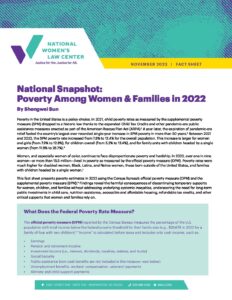Abortion rights, women of color, and LGBTQIA+ people are under attack. Pledge to join us in fighting for gender justice.

 Poverty in the United States is a policy choice. In 2021, child poverty rates as measured by the supplemental poverty measure (SPM) dropped to a historic low thanks to the expanded Child Tax Credits and other pandemic-era public assistance measures enacted as part of the American Rescue Plan Act (ARPA). A year later, the expiration of pandemic-era relief fueled the country’s largest ever recorded single-year increase in SPM poverty in more than 50 years. Between 2021 and 2022, the SPM poverty rate increased from 7.8% to 12.4% for the overall population. This increase is larger for women and girls (from 7.9% to 12.8%), for children overall (from 5.2% to 12.4%), and for family units with children headed by a single woman (from 11.9% to 26.7%).
Poverty in the United States is a policy choice. In 2021, child poverty rates as measured by the supplemental poverty measure (SPM) dropped to a historic low thanks to the expanded Child Tax Credits and other pandemic-era public assistance measures enacted as part of the American Rescue Plan Act (ARPA). A year later, the expiration of pandemic-era relief fueled the country’s largest ever recorded single-year increase in SPM poverty in more than 50 years. Between 2021 and 2022, the SPM poverty rate increased from 7.8% to 12.4% for the overall population. This increase is larger for women and girls (from 7.9% to 12.8%), for children overall (from 5.2% to 12.4%), and for family units with children headed by a single woman (from 11.9% to 26.7%).
This fact sheet presents poverty estimates in 2022 using the Census Bureau’s official poverty measure (OPM) and the supplemental poverty measure (SPM). Findings reveal the harmful consequences of discontinuing temporary supports for women, children, and families without addressing underlying systemic inequities, underscoring the need for long-term public investments in child care, nutrition assistance, accessible and affordable housing, refundable tax credits, and other critical supports that women and families rely on.
Past resources: See here for poverty numbers in 2021.
